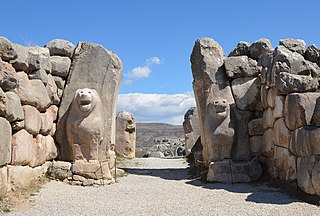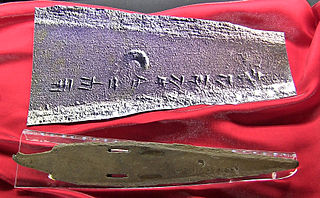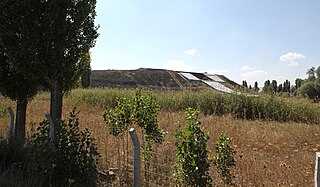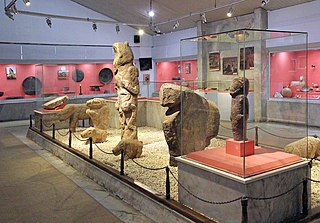
The Hittites were an Anatolian Indo-European people who formed one of the first major civilizations of Bronze Age West Asia. Possibly originating from beyond the Black Sea, they settled in modern-day Turkey in the early 2nd millennium BC. The Hittites formed a series of polities in north-central Anatolia, including the kingdom of Kussara, the Kanesh or Nesha kingdom, and an empire centered on Hattusa. Known in modern times as the Hittite Empire, it reached its peak during the mid-14th century BC under Šuppiluliuma I, when it encompassed most of Anatolia and parts of the northern Levant and Upper Mesopotamia, bordering the rival empires of the Hurri-Mitanni and Assyrians.

Kültepe, also known under its ancient name Kaneš or Neša (Nesha), is an archaeological site in Kayseri Province, Turkey. It was already a major settlement at the beginning of the 3rd millennium BC, but it is world-renowned for its significance at the beginning of the 2nd millennium BC. The archaeological site consists of a large mound, and a lower city, where a kārum was established in the beginning of the 2nd Millenium BC. So far, 23,500 cuneiform tablets recovered from private houses constitute the largest collection of private texts in the ancient Near East. In 2014, the archaeological site was inscribed in the Tentative list of World Heritage Sites in Turkey.

The Hattians were an ancient Bronze Age people that inhabited the land of Hatti, in central Anatolia. They spoke a distinctive Hattian language, which was neither Semitic nor Indo-European. Hattians are attested by archeological records from the Early Bronze Age and by historical references in later Hittite and other sources. Their main centre was the city of Hattush. Faced with Hittite expansion, Hattians were gradually absorbed into the new political and social order, imposed by the Hittites, who were one of the Indo-European-speaking Anatolian peoples. The Hittites kept the country name unchanged, which also became the main designation for the Hittite state.

Hattusa, also Hattuşa, Ḫattuša, Hattusas, or Hattusha, was the capital of the Hittite Empire in the late Bronze Age during two distinct periods. Its ruins lie near modern Boğazkale, Turkey, within the great loop of the Kızılırmak River.

Anitta, son of Pitḫana, reigned ca. 1740–1725 BC, and was a king of Kuššara, a city that has yet to be identified. He is the earliest known ruler to compose a text in the Hittite language.

Kussara (Kuššar) was a Middle Bronze Age kingdom in Anatolia. The kingdom, though apparently important at one time, is mostly remembered today as the origin of the dynasty that would form the Old Hittite Kingdom.

Alishar Hüyük was an ancient Near Eastern city. It is near the modern village of Alişar, Sorgun. It has been suggested that in the Iron Age the site was part of the polity of Tabal.

The Museum of Anatolian Civilizations is located on the south side of Ankara Castle in the Atpazarı area in Ankara, Turkey. It consists of the old Ottoman Mahmut Paşa bazaar storage building, and the Kurşunlu Han. Because of Atatürk's desire to establish a Hittite museum, the buildings were bought upon the suggestion of Hamit Zübeyir Koşay, who was then Culture Minister, to the National Education Minister, Saffet Arıkan. After the remodelling and repairs were completed (1938–1968), the building was opened to the public as the Ankara Archaeological Museum.

The National Museum of Aleppo is the largest museum in the city of Aleppo, Syria, and was founded in 1931. It is located in the heart of the northern city on Baron Street, adjacent to the famous Baron Hotel and near the Bab al-Faraj Square and Clock Tower. The majority of the museum's exhibitions are devoted to the archaeology of Syria, with most of the finds coming from archaeological sites of the northern part of the country.

Karum is the name given to ancient Old Assyrian period trade posts in Anatolia from the 20th to 18th centuries BC. The main centre of karum trading was at the ancient town of Kanesh.

Kaman-Kalehöyük is a multi-period archaeological site in Kırşehir Province, Turkey, around 100 km south east of Ankara, 6 km east of the town center of Kaman. It is a tell or mound site that was occupied during the Bronze Age, Iron Age and Ottoman periods. Excavations in the mound have been carried out since 1986 under the direction of Sachihiro Omura, on behalf of the Middle Eastern Culture Center in Japan and the Japanese Anatolian Archeology Institute. The distance to Hattusa, the Hittite capital, is about 100 km.

The prehistory of Anatolia stretches from the Paleolithic era through to the appearance of classical civilisation in the middle of the 1st millennium BC. It is generally regarded as being divided into three ages reflecting the dominant materials used for the making of domestic implements and weapons: Stone Age, Bronze Age and Iron Age. The term Copper Age (Chalcolithic) is used to denote the period straddling the stone and Bronze Ages.

Aydın Archaeological Museum is in Aydın, western Turkey. Established in 1959, it contains numerous statues, tombs, columns and stone carvings from the Hellenistic, Roman, Byzantine, Seljuk and Ottoman periods, unearthed in ancient cities such as Alinda, Alabanda, Amyzon, Harpasa, Magnesia on the Maeander, Mastaura, Myus, Nisa, Orthosia, Piginda, Pygela and Tralleis. The museum also has a section devoted to ancient coin finds.

Niğde Archaeological Museum is located in the centre of the Turkish provincial capital, Niğde between Dışarı Cami Sokak and Öğretmenler Caddesi. It contains objects found at sites in the surrounding area, including the tell of Köşk Höyük and the Graeco-Roman city of Tyana, both in the nearby town of Kemerhisar.

Acemhöyük is an archaeological site in Turkey. The tell is located near the village of Yeşilova in Merkez district, Aksaray Province. The Bronze Age name for the place was probably Purušḫanda/Purušḫattum or Ullama. The site was important during the Early Bronze Age as part of the Anatolian Trade Network and the Middle Bronze Age as a colony in the Assyrian Trade Network, with a trading post called Karum.

Şanlıurfa Archaeology and Mosaic Museums or Şanlıurfa Museum are located in the south-eastern city of Şanlıurfa, Turkey. The museums contain remains of Şanlıurfa, Göbekli Tepe, Karahan Tepe, Harran, findings from the Southeastern Anatolia Project and ruins found in the hydroelectric dam reservoirs of Atatürk Dam, Birecik Dam and Karkamış Dam. Both museums are located at Haleplibahçe Mahallesi 2372, Sok Eyyübiye/Şanlıurfa.
Anisa (Ανίσα) was a town of ancient Cappadocia, inhabited in Hellenistic, Roman, and Byzantine times. A source described Anisa as a politeumata, which was a township for privileged foreigners. Although it did not control any territory outside its jurisdiction, it enjoyed internal self-government.
Ḫaḫḫum, also known as Hahha, was a city in ancient Mesopotamia located near the Balikh river. Hahnum was located near a trade route.

Caesarea, also known historically as Mazaca, was an ancient city in what is now Kayseri, Turkey. In Hellenistic and Roman times, the city was an important stop for merchants headed to Europe on the ancient Silk Road. The city was the capital of Cappadocia, and Armenian and Cappadocian kings regularly fought over control of the strategic city. The city was renowned for its bishops of both the Greek Orthodox and Armenian Apostolic churches. After the Battle of Manzikert where the Byzantine Empire lost to the incoming Seljuk Empire, the city was later taken over by the Sultanate of Rum and became reconfigured over time with the influences of both Islamic and, later, Ottoman architecture.

















